Tillage Practices and Liming: Comparative Study of Soil Properties and Forage Corn Production
Abstract
1. Introduction
2. Materials and Methods
2.1. Location and Description
2.2. Experimental Design and Treatments
2.3. Liming and Crop Management
2.4. Measurement of Variables
2.4.1. Soil Biological Variables
Soil CO2 Emissions
Earthworm Population
2.4.2. Soil Physical Variables
Gravimetric Moisture (M°) and Bulk Density (Bd)
Hydraulic Conductivity (Ks)
2.4.3. Soil Chemical Variables
2.4.4. Biometrics and Foliar Nutrients Content Variables
Height, Leaf Area Index, Green and Dry Forage Corn
N, P, K, Ca, Mg Foliar Content
2.5. Statistical Analysis
3. Results and Discussion
3.1. Soil Biological Variable
3.1.1. Soil CO2 Emission
3.1.2. Earthworm Population
3.2. Soil Physical Variables
3.2.1. Gravimetric Moisture (M°)
3.2.2. Bulk Density (Bd)
3.2.3. Hydraulic Conductivity (Ks)
3.3. Soil Chemistry Variables
3.4. Biometric and Foliar Variables of Forage Corn
3.4.1. Height, Leaf Area Index (LAI), Green and Dry Forage Yield
3.4.2. Foliar N, P, Ca, and Mg
4. Conclusions
Author Contributions
Funding
Data Availability Statement
Acknowledgments
Conflicts of Interest
References
- Han, K.; Liu, B.; Liu, P.; Wang, Z. The Optimal Plant Density of Maize for Dairy Cow Forage Production. Agron. J. 2020, 112, 1849–1861. [Google Scholar] [CrossRef]
- Blanco-Moure, N.; Moret-Fernández, D.; López, M.V. Dynamics of Aggregate Destabilization by Water in Soils under Long-Term Conservation Tillage in Semiarid Spain. Catena 2012, 99, 34–41. [Google Scholar] [CrossRef]
- Petito, M.; Cantalamessa, S.; Pagnani, G.; Degiorgio, F.; Parisse, B.; Pisante, M. Impact of Conservation Agriculture on Soil Erosion in the Annual Cropland of the Apulia Region (Southern Italy) Based on the RUSLE-GIS-GEE Framework. Agronomy 2022, 12, 281. [Google Scholar] [CrossRef]
- FAO. El Estado de Los Recursos de Tierras y Aguas Del Mundo Para La Alimentación y La Agricultura: La Gestión de Los Sistemas En Situación de Riesgo; Mundi-Prensa, Organización de las Naciones Unidas para la Alimentación y la Agricultura (FAO): Madrid, Spain, 2012; ISBN 9788484765530. [Google Scholar]
- Busari, M.A.; Kukal, S.S.; Kaur, A.; Bhatt, R.; Dulazi, A.A. Conservation Tillage Impacts on Soil, Crop and the Environment. Int. Soil Water Conserv. Res. 2015, 3, 119–129. [Google Scholar] [CrossRef]
- Mehdizade, B.; Asadi, H.; Shabanpour, M.; Ghadiri, H. Impact of Erosion and Tillage on the Productivity and Quality of Selected Semiarid Soils of Iran. Int. Agrophys. 2013, 27, 291–297. [Google Scholar] [CrossRef]
- Rodriguez, F. El Recurso Del Suelo En La Amazonia Peruana, Diagnostico Para Su Investigacion (Segunda Aproximación); Instituto de Investigaciones de la Amazonía Peruana: Iquitos, Peru, 1995; pp. 40–41. [Google Scholar]
- Fierer, N.; Jackson, R.B. The Diversity and Biogeography of Soil Bacterial Communities. Proc. Natl. Acad. Sci. USA 2006, 103, 626–631. [Google Scholar] [CrossRef] [PubMed]
- Villagaray Yanqui, S.M. Recuperación de Terrenos Degradados Por El Cultivo de Coca (Erythroxylon Coca) En VRAEM, Perú, Con Aplicación de Tecnología Agroforestal. Rev. Acta Nova 2014, 6, 210–2025. [Google Scholar]
- Celis-Tarazona, R.; Rofner, N.F.; Rojas, A.R. Impacto sobre indicadores físicos y químicos del suelo con manejo convencional de coca y cacao. Ciencia Unemi 2020, 13, 1–9. [Google Scholar] [CrossRef]
- MIDAGRI. Elaboración de Mapa de Suelos y Clasificación de Tierras Por Su Capacidad de Uso Mayor (CTCUM) Del Departamento de Ucayali En El Marco Del Proceso de La Zonificación Forestal. 2022. Available online: https://www.gob.pe/institucion/midagri/normas-legales/3638855-656-2022-midagri-dvdafir-dgaaa (accessed on 8 February 2024).
- Luque-Ramos, L. Análisis de La Deforestación de La Amazonia Peruana: Madre de Dios. Rev. Innova Educ. 2021, 3, 198–212. [Google Scholar] [CrossRef]
- Ráez-Luna, E.; Dourojeanni, M.J. Los Principales Problemas Ambientales Políticamente Relevantes en el Perú; SINIA MINAM: Lima, Peru, 2016. [Google Scholar]
- Pisante, M.; Stagnari, F.; Grandi, M.; Elias, G.; Santilocchi, R.; Tabaglio, V. Agricoltura BLU La Via Italiana dell’Agricoltura Conservativa Manuale Abbreviato; GISERVICE: Potenza, Italy, 2011. [Google Scholar]
- Sartori, F.; Piccoli, I.; Polese, R.; Berti, A. Transition to Conservation Agriculture: How Tillage Intensity and Covering Affect Soil Physical Parameters. SOIL 2022, 8, 213–222. [Google Scholar] [CrossRef]
- Derpsch, R.; Friedrich, T.; Kassam, A.; Hongwen, L. Current Status of Adoption of No-till Farming in the World and Some of Its Main Benefits. Int. J. Agric. Biol. Eng. 2010, 3, 1–25. [Google Scholar] [CrossRef]
- Lal, R.; Reicosky, D.C.; Hanson, J.D. Evolution of the Plow over 10,000 Years and the Rationale for No-till Farming. Soil Tillage Res. 2007, 93, 1–12. [Google Scholar] [CrossRef]
- Mcinga, S.; Muzangwa, L.; Janhi, K.; Mnkeni, P.N.S. Conservation Agriculture Practices Can Improve Earthworm Species Richness and Abundance in the Semi-Arid Climate of Eastern Cape, South Africa. Agriculture 2020, 10, 576. [Google Scholar] [CrossRef]
- Muoni, T.; Mhlanga, B.; Forkman, J.; Sitali, M.; Thierfelder, C. Tillage and Crop Rotations Enhance Populations of Earthworms, Termites, Dung Beetles and Centipedes: Evidence from a Long-Term Trial in Zambia. J. Agric. Sci. 2019, 157, 504–514. [Google Scholar] [CrossRef]
- Singh, S.; Sharma, A.; Khajuria, K.; Singh, J.; Vig, A.P. Soil Properties Changes Earthworm Diversity Indices in Different Agro-Ecosystem. BMC Ecol. 2020, 20, 27. [Google Scholar] [CrossRef]
- Alam, M.K.; Bell, R.W.; Haque, M.E.; Kader, M.A. Minimal Soil Disturbance and Increased Residue Retention Increase Soil Carbon in Rice-Based Cropping Systems on the Eastern Gangetic Plain. Soil Tillage Res. 2018, 183, 28–41. [Google Scholar] [CrossRef]
- Cárceles Rodríguez, B.; Durán-Zuazo, V.H.; Soriano Rodríguez, M.; García-Tejero, I.F.; Gálvez Ruiz, B.; Cuadros Tavira, S. Conservation Agriculture as a Sustainable System for Soil Health: A Review. Soil Syst. 2022, 6, 87. [Google Scholar] [CrossRef]
- La Scala, N.; Bolonhezi, D.; Pereira, G.T. Short-Term Soil CO2 Emission after Conventional and Reduced Tillage of a No-till Sugar Cane Area in Southern Brazil. Handb. Environ. Chem. Vol. 5 Water Pollut. 2006, 91, 244–248. [Google Scholar] [CrossRef]
- Power, A.G. Ecosystem services and agriculture: Tradeoffs and synergies. Philos. Trans. R. Soc. Lond. B Biol. Sci. 2010, 365, 2959–2971. [Google Scholar] [CrossRef] [PubMed]
- Dainese, M.; Martin, E.A.; Aizen, M.A.; Albrecht, M.; Bartomeus, I.; Bommarco, R.; Carvalheiro, L.G.; Chaplin-Kramer, R.; Gagic, V.; Garibaldi, L.A.; et al. A global synthesis reveals biodiversity-mediated benefits for crop production. Sci. Adv. 2019, 5, eaax0121. [Google Scholar] [CrossRef] [PubMed]
- Thierfelder, C.; Wall, P.C. Rotation in Conservation Agriculture Systems of Zambia: Effects on Soil Quality and Water Relations. Exp. Agric. 2010, 46, 309–325. [Google Scholar] [CrossRef]
- Nyamangara, J.; Marondedze, A.; Masvaya, E.N.; Mawodza, T.; Nyawasha, R.; Nyengerai, K.; Tirivavi, R.; Nyamugafata, P.; Wuta, M. Influence of Basin-Based Conservation Agriculture on Selected Soil Quality Parameters under Smallholder Farming in Zimbabwe. Soil Use Manag. 2014, 30, 550–559. [Google Scholar] [CrossRef]
- Carbonell-Bojollo, R.; Veroz-Gonzalez, O.; Ordoñez-Fernandez, R.; Moreno-Garcia, M.; Basch, G.; Kassam, A.; de Torres, M.A.R.R.; Gonzalez-Sanchez, E.J. The Effect of Conservation Agriculture and Environmental Factors on CO2 Emissions in a Rainfed Crop Rotation. Sustainability 2019, 11, 3955. [Google Scholar] [CrossRef]
- Mloza-Banda, H.R.; Makwiza, C.N.; Mloza-Banda, M.L. Soil Properties after Conversion to Conservation Agriculture from Ridge Tillage in Southern Malawi. J. Arid. Environ. 2016, 127, 7–16. [Google Scholar] [CrossRef]
- Toufeeq, S.; Dhalin, D.; Khatawkar, D.S.; Subhagan, S.R. Effect of Tillage Methods on CO2 Emission from Red Loam Soil of Kerala. Int. J. Curr. Microbiol. Appl. Sci. 2020, 9, 2827–2837. [Google Scholar] [CrossRef]
- Jayaraman, S.; Sahu, M.; Sinha, N.K.; Mohanty, M.; Chaudhary, R.S.; Yadav, B.; Srivastava, L.K.; Hati, K.M.; Patra, A.K.; Dalal, R.C. Conservation Agricultural Practices Impact on Soil Organic Carbon, Soil Aggregation and Greenhouse Gas Emission in a Vertisol. Agriculture 2022, 12, 1004. [Google Scholar] [CrossRef]
- Mühlbachová, G.; Kusá, H.; Růžek, P.; Vavera, R. CO2 Emissions in a Soil under Different Tillage Practices. Plant Soil Environ. 2022, 68, 253–261. [Google Scholar] [CrossRef]
- Perrino, E.V.; Ladisa, G.; Calabrese, G. Flora and plant genetic resources of ancient olive groves of Apulia (Southern Italy). Genet. Resour. Crop Evol. 2014, 61, 23–53. [Google Scholar] [CrossRef]
- Rahman, M.A.; Lee, S.H.; Ji, H.C.; Kabir, A.H.; Jones, C.S.; Lee, K.W. Importance of Mineral Nutrition for Mitigating Aluminum Toxicity in Plants on Acidic Soils: Current Status and Opportunities. Int. J. Mol. Sci. 2018, 19, 3073. [Google Scholar] [CrossRef]
- Gazey, C.; Davies, S. Soil Acidity A Guide for WA Farmers and Consultants; Department of Agriculture and Food: South Perth, Australia, 2009. [Google Scholar]
- Cavalieri, K.M.V.; Tormena, C.A.; Filho, P.S.V.; Gonçalves, A.C.A.; Costa, A.C.S.d. Efeitos de sistemas de preparo nas propriedades físicas de um latossolo vermelho distrófico. Rev. Bras. Ciência Solo 2006, 30, 137–147. [Google Scholar] [CrossRef]
- Tiritan, C.S.; Büll, L.T.; Crusciol, C.A.C.; Carmeis Filho, A.C.A.; Fernandes, D.M.; Nascente, A.S. Tillage System and Lime Application in a Tropical Region: Soil Chemical Fertility and Corn Yield in Succession to Degraded Pastures. Soil Tillage Res. 2016, 155, 437–447. [Google Scholar] [CrossRef]
- Crusciol, C.A.C.; Marques, R.R.; Carmeis Filho, A.C.A.; Soratto, R.P.; Costa, C.H.M.; Ferrari Neto, J.; Castro, G.S.A.; Pariz, C.M.; Castilhos, A.M.; Franzluebbers, A.J. Lime and Gypsum Combination Improves Crop and Forage Yields and Estimated Meat Production and Revenue in a Variable Charge Tropical Soil. Nutr. Cycl. Agroecosyst. 2019, 115, 347–372. [Google Scholar] [CrossRef]
- Mutsamba, E.F.; Nyagumbo, I.; Mupangwa, W. Forage and Maize Yields in Mixed Crop-Livestock Farming Systems: Enhancing Forage and Maize Yields in Mixed Crop-Livestock Systems under Conservation Agriculture in Sub-Humid Zimbabwe. NJAS: Wagening. J. Life Sci. 2020, 92, 100317. [Google Scholar] [CrossRef]
- Gobierno Regional de la Region Ucayali. Zonificación Ecológica Económica Base para el Ordena-Miento Territorial de la Región Ucayali; Gobierno regional de Ucayali: Pucallpa, Perú, 2017. [Google Scholar]
- Anderson, J.P. Soil respiration. Agron. Monogr. 2015, 831–871. [Google Scholar] [CrossRef]
- Bazán, R. Manual de Procedimientos de Los Análisis de Suelos y Agua con Fines de Riego Programa Presupuestal 0089 Reducción de la Degradación de los Suelos Agrarios; Instituto Nacional de Innovacion Agraria–INIA: Lima, Perú, 2017. [Google Scholar]
- Boonchamni, C.; Boonthai Iwai, C.; Ta-Oun, M. Physical-Chemical Properties of Earthworm Casts in Different Earthworm Species. Int. J. Environ. Rural. Dev. 2019, 1, 1–5. [Google Scholar]
- Álvaro-Fuentes, J.; Lóczy, D.; Thiele-Bruhn, S.; Zornoza, R. Handbook of Plant and Soil Analysis for Agricultural Systems. Diversification and Low-Input Farming across Europe: From Practitioners’ Engagement and Ecosystems Services to Increased Revenues and Value Chain Organisation; Universidad Politécnica de Cartagena: Cartagena, Spain, 2019; ISBN 9788416325863. [Google Scholar]
- Sonmez, S.; Buyuktas, D.; Okturen, F.; Citak, S. Assessment of different soil to water ratios (1:1, 1:2.5, 1:5) in soil salinity studies. Geoderma 2008, 144, 361–369. [Google Scholar] [CrossRef]
- Schinner, F.; Öhlinger, R.; Kandeler, E.; Margesin, R. (Eds.) Methods in Soil Biology; Springer: Berlin/Heidelberg, Germany, 1995. [Google Scholar]
- Silva-Olaya, A.M.; Cerri, C.E.P.; La Scala, N.; Dias, C.T.S.; Cerri, C.C. Carbon Dioxide Emissions under Different Soil Tillage Systems in Mechanically Harvested Sugarcane. Environ. Res. Lett. 2013, 8, 015014. [Google Scholar] [CrossRef]
- Farhate, C.V.V.; de Souza, Z.M.; La Scala, N.; de Sousa, A.C.M.; Santos, A.P.G.; Carvalho, J.L.N. Soil Tillage and Cover Crop on Soil CO2 Emissions from Sugarcane Fields. Soil Use Manag. 2019, 35, 273–282. [Google Scholar] [CrossRef]
- Álvaro-Fuentes, J.; Cantero-Martínez, C.; López, M.V.; Arrúe, J.L. Soil Carbon Dioxide Fluxes Following Tillage in Semiarid Mediterranean Agroecosystems. Soil Tillage Res. 2007, 96, 331–341. [Google Scholar] [CrossRef]
- Bilgili, A.V.; Yilmaz, G.; Ikinci, A. Modeling Temporal Variability of Soil CO2 Emissions from an Apple Orchard in the Harran Plain of Southeastern Turkey. Turk. J. Agric. For. 2013, 37, 744–761. [Google Scholar] [CrossRef]
- Blanchart, E.; Albrechf, A.; Alegre, J.; Duboisset, A.; Giloe, C.; Pashanasf, B.; Lavelle, P.; Brussaard, L. Effects of Earthworms on Soil Structu Re and Physical Properties. In Earthworm Management in Tropical Agroecosystems; Lavelle, P., Brussaard, L., Hendrix, P., Eds.; CABI Publishing: Wallingford, UK, 1999; pp. 149–172. ISBN 0-85199-270-6. [Google Scholar]
- van Capelle, C.; Schrader, S.; Brunotte, J. Tillage-Induced Changes in the Functional Diversity of Soil Biota—A Review with a Focus on German Data. Eur. J. Soil Biol. 2012, 50, 165–181. [Google Scholar] [CrossRef]
- Nurul Aini, S.; Yusnaini, S.; Niswati, A. Minimum Tillage and in Situ Mulch Increasing the Population and Biomass of Earthworms Under Mung Bean Cultivation on Ultisol Soil. J. Trop. Soils 2019, 24, 141–148. [Google Scholar] [CrossRef]
- Chan, K.Y. An Overview of Some Tillage Impacts on Earthworm Population Abundance and Diversity Ð Implications for Functioning in Soils. Soil Tillage Res. 2001, 57, 179–191. [Google Scholar] [CrossRef]
- Birkás, M.; Jolánkai, M.; Gyuricza, C.; Percze, A. Tillage Effects on Compaction, Earthworms and Other Soil Quality Indicators in Hungary. Soil Tillage Res. 2004, 78, 185–196. [Google Scholar] [CrossRef]
- Lemtiri, A.; Colinet, G.; Alabi, T.; Cluzeau, D.; Zirbes, L.; Haubruge, É.; Francis, F. Impacts of Earthworms on Soil Components and Dynamics. A Review. Biotechnol. Agron. Soc. Environ. 2014, 18, 121–133. [Google Scholar]
- Lenka, N.K.; Meena, B.P.; Lal, R.; Khandagle, A.; Lenka, S.; Shirale, A.O. Comparing Four Indexing Approaches to Define Soil Quality in an Intensively Cropped Region of Northern India. Front. Environ. Sci. 2022, 10, 865473. [Google Scholar] [CrossRef]
- Shukla, A.; Kumar, M.; Verma, S.K.; Shukla, A. Effect of Tillage and Precision Nitrogen Management Practices on N Uptake and Nutrient Use Efficiency (NUE) in Wheat in Western Uttar Pradesh, India. Int. J. Plant Soil Sci. 2023, 35, 801–808. [Google Scholar] [CrossRef]
- da Veiga, M.; Reinert, D.J.; Reichert, J.M.; Kaiser, D.R. Short and Long-Term Effects of Tillage Systems and Nutrient Sources on Soil Physical Properties of a Southern Brazilian Hapludox. Rev. Bras. Cienc. Solo 2008, 32, 1437–1446. [Google Scholar] [CrossRef][Green Version]
- Monneveux, P.; Quillérou, E.; Sanchez, C.; Lopez-Cesati, J. Effect of Zero Tillage and Residues Conservation on Continuous Maize Cropping in a Subtropical Environment (Mexico). Plant Soil 2006, 279, 95–105. [Google Scholar] [CrossRef]
- Nyambo, P.; Chiduza, C.; Araya, T. Effect of Conservation Agriculture on Selected Soil Physical Properties on a Haplic Cambisol in Alice, Eastern Cape, South Africa. Arch. Agron. Soil Sci. 2022, 68, 195–208. [Google Scholar] [CrossRef]
- Guan, D.; Al-Kaisi, M.M.; Zhang, Y.; Duan, L.; Tan, W.; Zhang, M.; Li, Z. Tillage Practices Affect Biomass and Grain Yield through Regulating Root Growth, Root-Bleeding Sap and Nutrients Uptake in Summer Maize. Field Crops Res. 2014, 157, 89–97. [Google Scholar] [CrossRef]
- Bai, L.; Kong, X.; Li, H.; Zhu, H.; Wang, C.; Ma, S. Effects of Conservation Tillage on Soil Properties and Maize Yield in Karst Regions, Southwest China. Agriculture 2022, 12, 1449. [Google Scholar] [CrossRef]
- Cerdà, A.; Rodrigo-Comino, J.; Yakupoğlu, T.; Dindaroğlu, T.; Terol, E.; Mora-Navarro, G.; Arabameri, A.; Radziemska, M.; Novara, A.; Kavian, A.; et al. Tillage versus No-Tillage. Soil Properties and Hydrology in an Organic Persimmon Farm in Eastern Iberian Peninsula. Water 2020, 12, 1539. [Google Scholar] [CrossRef]
- Sithole, N.J.; Magwaza, L.S.; Thibaud, G.R. Long-Term Impact of No-till Conservation Agriculture and N-Fertilizer on Soil Aggregate Stability, Infiltration and Distribution of C in Different Size Fractions. Soil Tillage Res. 2019, 190, 147–156. [Google Scholar] [CrossRef]
- Etim Udom, B.; Ehilegbu, J. Critical Moisture Content, Bulk Density Relationships and Compaction of Cultivated and Uncultivated Soils in the Humid Tropics. Asian Soil Res. J. 2018, 1, 1–9. [Google Scholar] [CrossRef][Green Version]
- Enkova, L.K.; Urík, M. Soil Moisture and Its Effect on Bulk Density and Porosity of Intact Aggregates of Three Mollic Soils. Indian J. Agric. Sci. 2012, 82, 172–176. [Google Scholar] [CrossRef]
- Marschner, P. Marschner’s Mineral Nutrition of Higher Plants; Elsevier: Amsterdam, The Netherlands, 2012; ISBN 9780123849052. [Google Scholar] [CrossRef]
- Fuentes, J.P.; Flury, M.; Bezdicek, D.F. Hydraulic Properties in a Silt Loam Soil under Natural Prairie, Conventional Till, and No–Till. Soil Sci. Soc. Am. J. 2004, 68, 1679–1688. [Google Scholar] [CrossRef]
- Hu, W.; Shao, M.; Wang, Q.; Fan, J.; Horton, R. Temporal Changes of Soil Hydraulic Properties under Different Land Uses. Geoderma 2009, 149, 355–366. [Google Scholar] [CrossRef]
- Mondal, S.; Poonia, S.P.; Mishra, J.S.; Bhatt, B.P.; Karnena, K.R.; Saurabh, K.; Kumar, R.; Chakraborty, D. Short-Term (5 Years) Impact of Conservation Agriculture on Soil Physical Properties and Organic Carbon in a Rice–Wheat Rotation in the Indo-Gangetic Plains of Bihar. Eur. J. Soil Sci. 2020, 71, 1076–1089. [Google Scholar] [CrossRef]
- Nebo, G.I.; Manyevere, A.; Araya, T.; van Tol, J. Short-Term Impact of Conservation Agriculture on Soil Strength and Saturated Hydraulic Conductivity in the South African Semiarid Areas. Agriculture 2020, 10, 414. [Google Scholar] [CrossRef]
- Shaaban, M.; Wu, Y.; Wu, L.; Hu, R.; Younas, A.; Nunez-Delgado, A.; Xu, P.; Sun, Z.; Lin, S.; Xu, X.; et al. The Effects of PH Change through Liming on Soil N2O Emissions. Processes 2020, 8, 702. [Google Scholar] [CrossRef]
- Mahmud, M.S.; Chong, K.P. Effects of Liming on Soil Properties and Its Roles in Increasing the Productivity and Profitability of the Oil Palm Industry in Malaysia. Agriculture 2022, 12, 322. [Google Scholar] [CrossRef]
- Rheinheimer, D.S.; Santos, E.J.S.; Kaminski, J.; Bortoluzzi, E.C.; Gatiboni, L.C. Alterações de Atributos Do Solo Pela Calagem Superficial e Incorporada a Partir de Pastagem Natural. Rev. Bras. Cienc. Solo 2000, 24, 797–805. [Google Scholar] [CrossRef]
- Díaz Durán, M.Á.; Ochoa, C.A.; Álvarez, J.W.; Rincón Numpaque, Á.H. Toxicidad por aluminio (Al3+) como limitante del crecimiento y la productividad: Experiencias en diagnóstico y manejo en Palmeras de Yarima S. A. (Santander). Palmas 2022, 43, 102–116. [Google Scholar]
- de Morais, E.G.; Jindo, K.; Silva, C.A. Biochar-Based Phosphate Fertilizers: Synthesis, Properties, Kinetics of P Release and Recommendation for Crops Grown in Oxisols. Agronomy 2023, 13, 326. [Google Scholar] [CrossRef]
- Iglesias, S.; Alegre, J.; Salas, C.; Egüez, J. Corn Yield (Zea Mays L.) Improves with the Use of Eucalyptus Biochar. Sci. Agropecu. 2018, 9, 25–32. [Google Scholar] [CrossRef]
- Ishfaq, M.; Wang, Y.; Yan, M.; Wang, Z.; Wu, L.; Li, C.; Li, X. Physiological Essence of Magnesium in Plants and Its Widespread Deficiency in the Farming System of China. Front. Plant Sci. 2022, 13, 802274. [Google Scholar] [CrossRef] [PubMed]
- Martínez Gamiño, M.Á.; Osuna Ceja, E.S.; Espinosa Ramírez, M. Impacto Acumulado de La Agricultura de Conservación En Propiedades Del Suelo y Rendimiento de Maíz. Rev. Mex. Cienc. Agric. 2019, 10, 765–778. [Google Scholar] [CrossRef]
- Pagani, A.; Mallarino, A.P. Soil PH and Crop Grain Yield as Affected by the Source and Rate of Lime. Soil Sci. Soc. Am. J. 2012, 76, 1877–1886. [Google Scholar] [CrossRef]
- Stevens, G.; Gladbach, T.; Motavalli, P.; Dunn, D. Soil Calcium: Magnesium Ratios and Lime Recommendations for Cotton. J. Cotton Sci. 2005, 9, 65–71. [Google Scholar]
- Nogaroli, J.A.; da Fonseca, A.F. Yield Index of Crops Grown under No-Tillage after Superficial Application of Micronized Liming Materials (MLM) on the Soil. Aust. J. Crop Sci. 2020, 14, 187–195. [Google Scholar] [CrossRef]
- Tian, G.; Qi, D.; Zhu, J.; Xu, Y. Effects of Nitrogen Fertilizer Rates and Waterlogging on Leaf Physiological Characteristics and Grain Yield of Maize. Arch. Agron. Soil Sci. 2020, 67, 863–875. [Google Scholar] [CrossRef]
- do Moraes Gatti, V.C.; da Silva Barata, H.; Silva, V.F.A.; da Cunha, F.F.; de Oliveira, R.A.; de Oliveira, J.T.; Silva, P.A. Influence of Calcium on the Development of Corn Plants Grown in Hydroponics. AgriEngineering 2023, 5, 623–630. [Google Scholar] [CrossRef]
- Wang, J.; Geng, Y.; Zhang, J.; Li, L.; Guo, F.; Yang, S.; Zou, J.; Wan, S. Increasing Calcium and Decreasing Nitrogen Fertilizers Improves Peanut Growth and Productivity by Enhancing Photosynthetic Efficiency and Nutrient Accumulation in Acidic Red Soil. Agronomy 2023, 13, 1924. [Google Scholar] [CrossRef]
- Ndayisaba, P.C.; Kuyah, S.; Midega, C.A.O.; Mwangi, P.N.; Khan, Z.R. Intercropping Desmodium and Maize Improves Nitrogen and Phosphorus Availability and Performance of Maize in Kenya. Field Crops Res. 2021, 263, 108067. [Google Scholar] [CrossRef]
- Topp, G.C.; Dow, B.; Edwards, M.; Gregorich, E.G.; Curnoe, W.E.; Cook, F.J. Oxygen Measurements in the Root Zone Facilitated by TDR. Can. J. Soil Sci. 2000, 80, 33–41. [Google Scholar] [CrossRef][Green Version]
- Naeem, A.; Deppermann, P.; Mühling, K.H. Ammonium Fertilization Enhances Nutrient Uptake, Specifically Manganese and Zinc, and Growth of Maize in Unlimed and Limed Acidic Sandy Soil. Nitrogen 2023, 4, 239–252. [Google Scholar] [CrossRef]
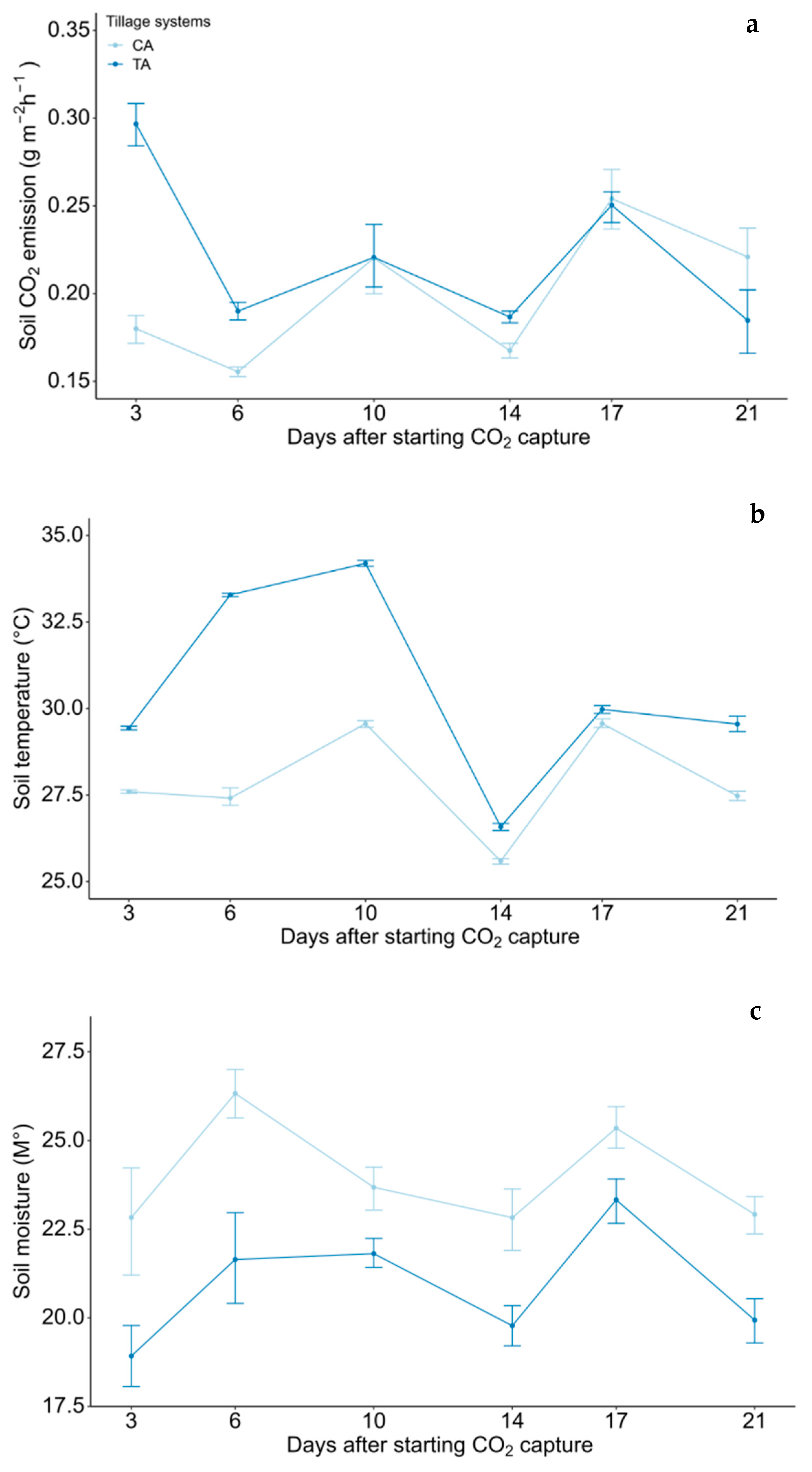
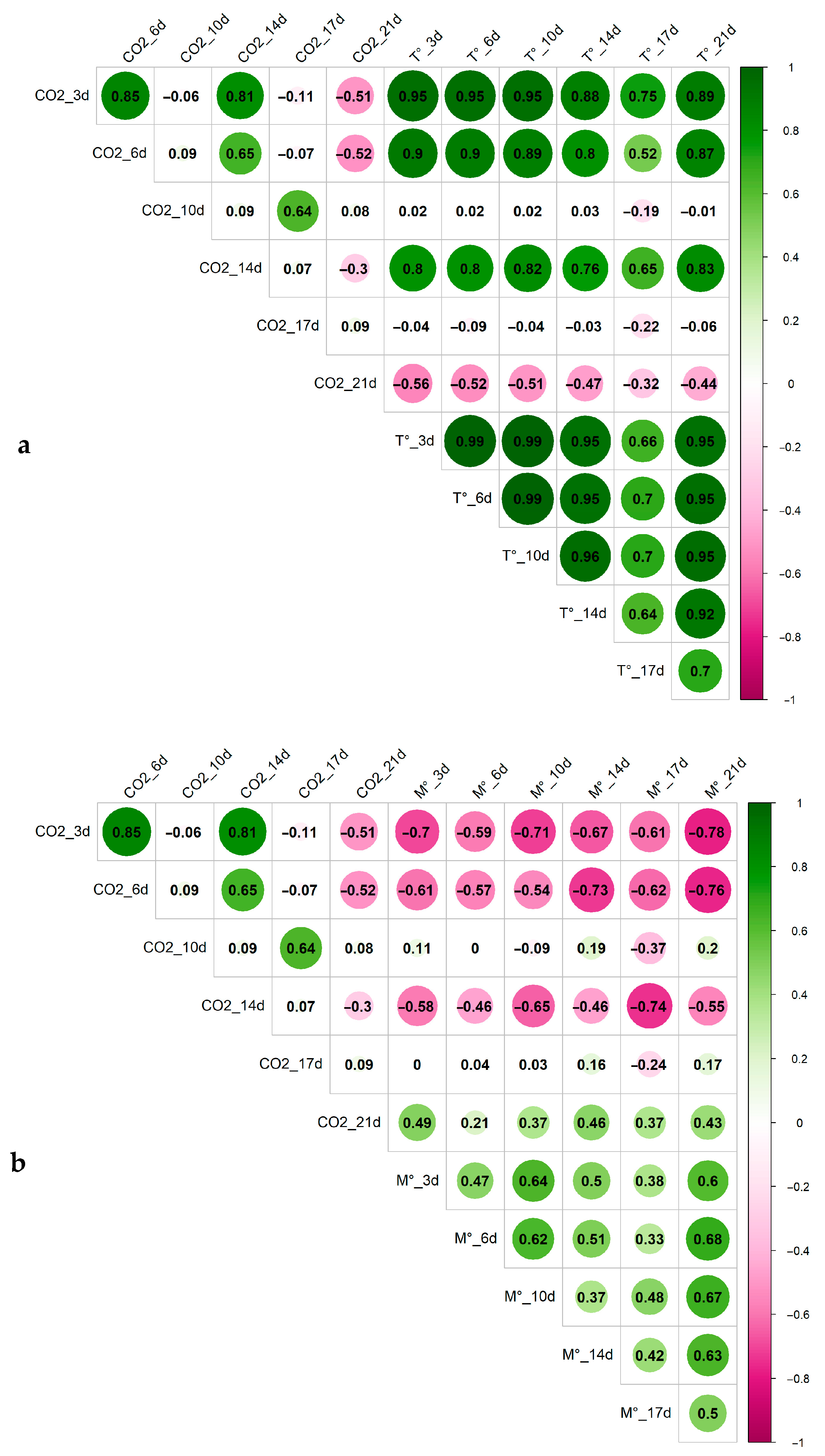
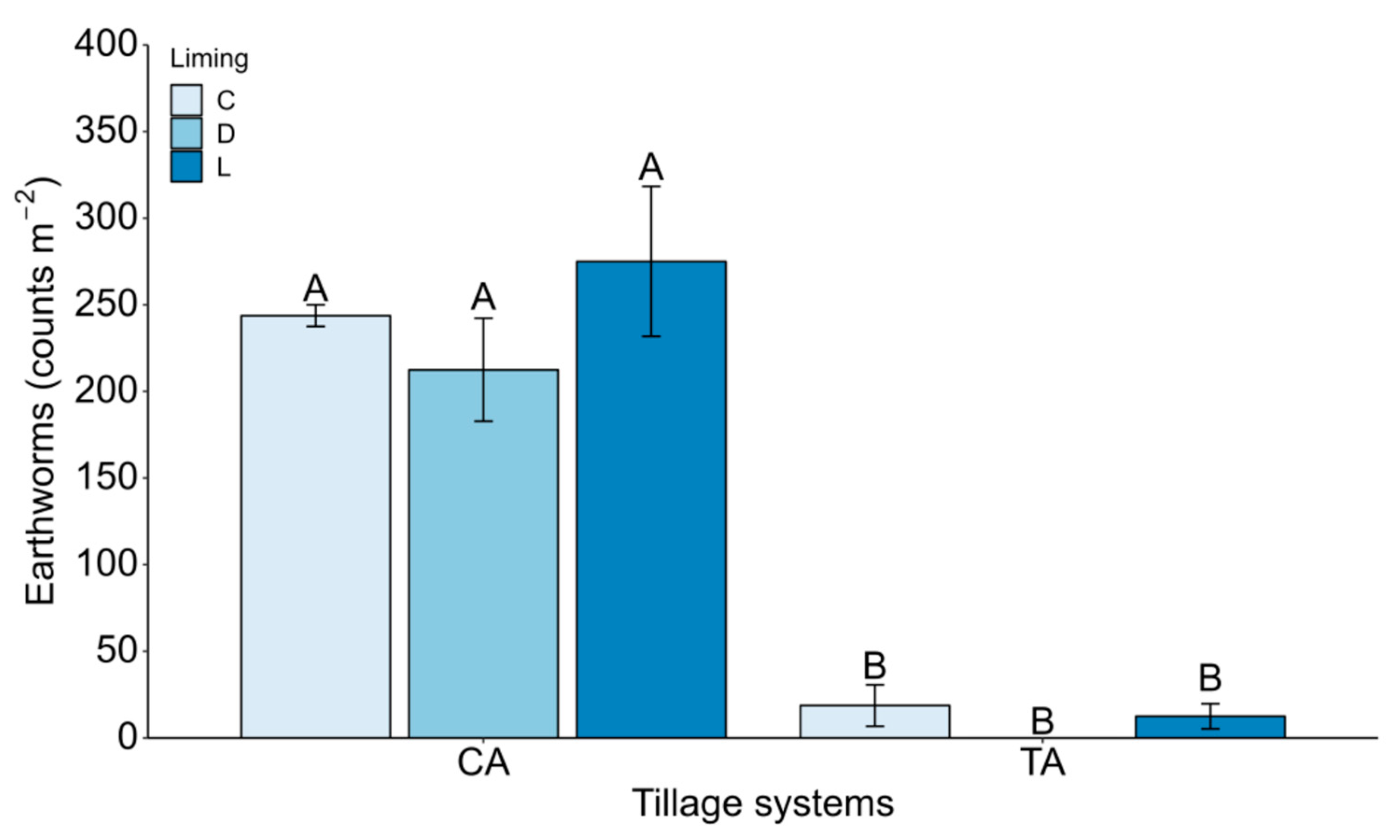
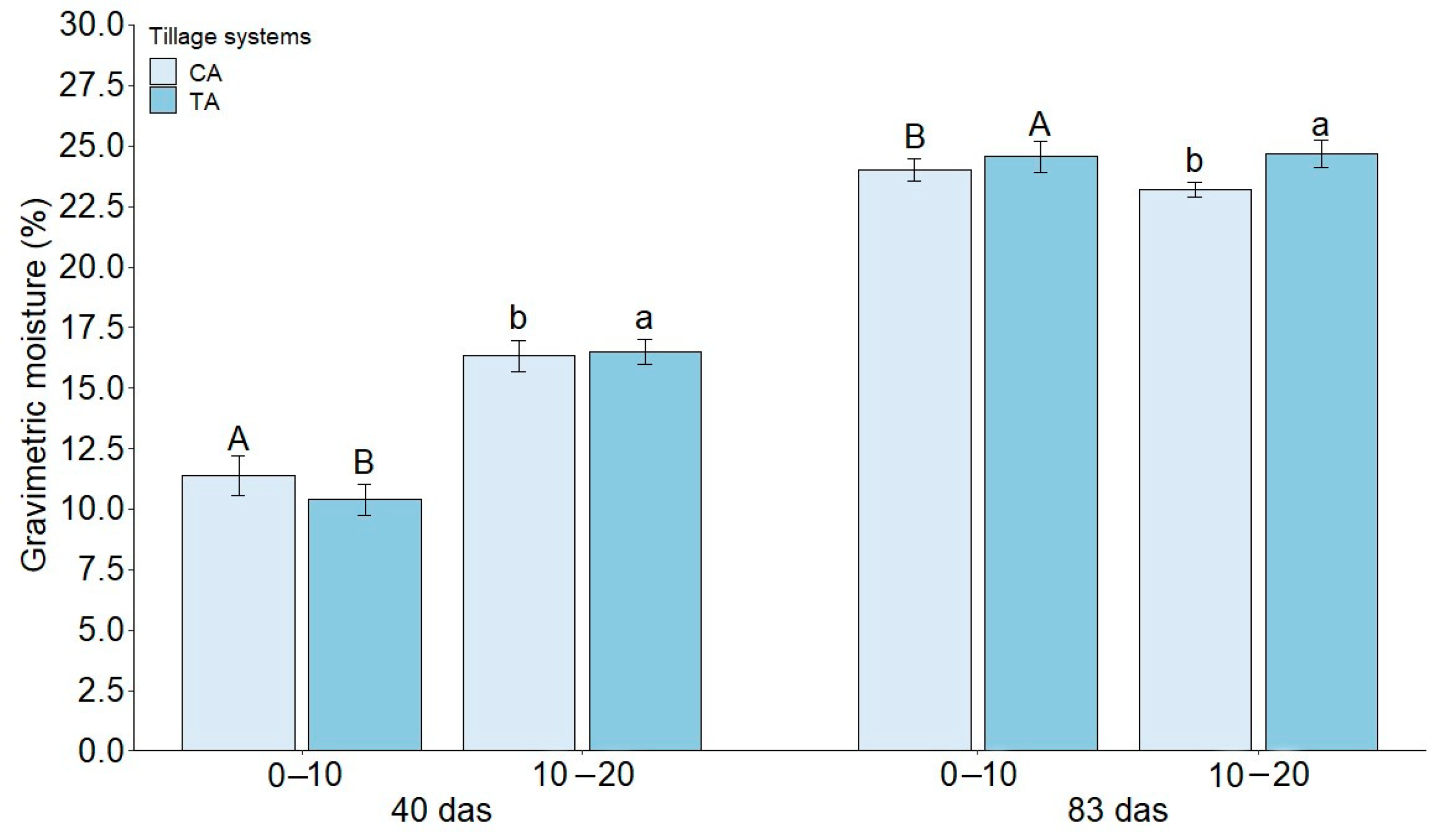
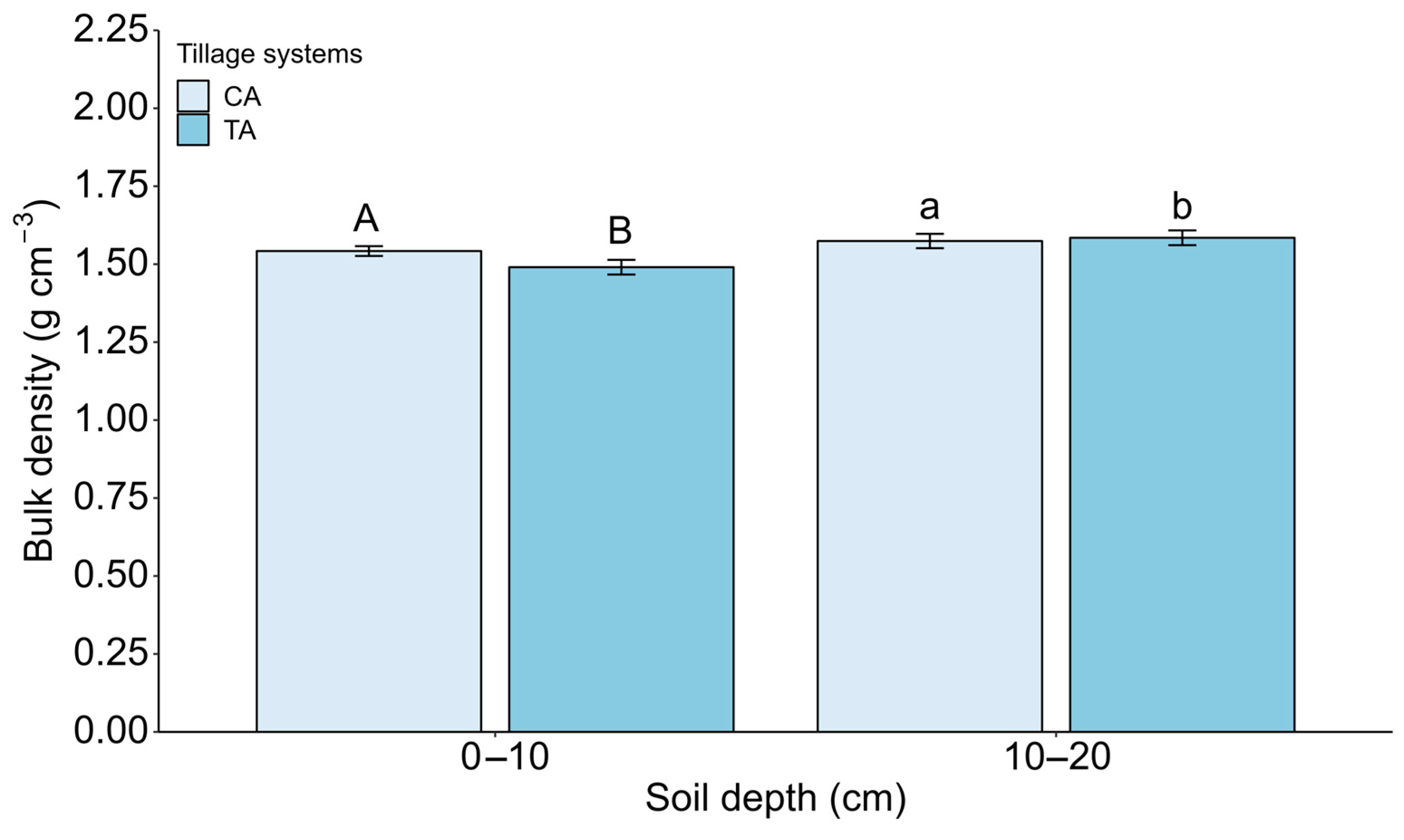
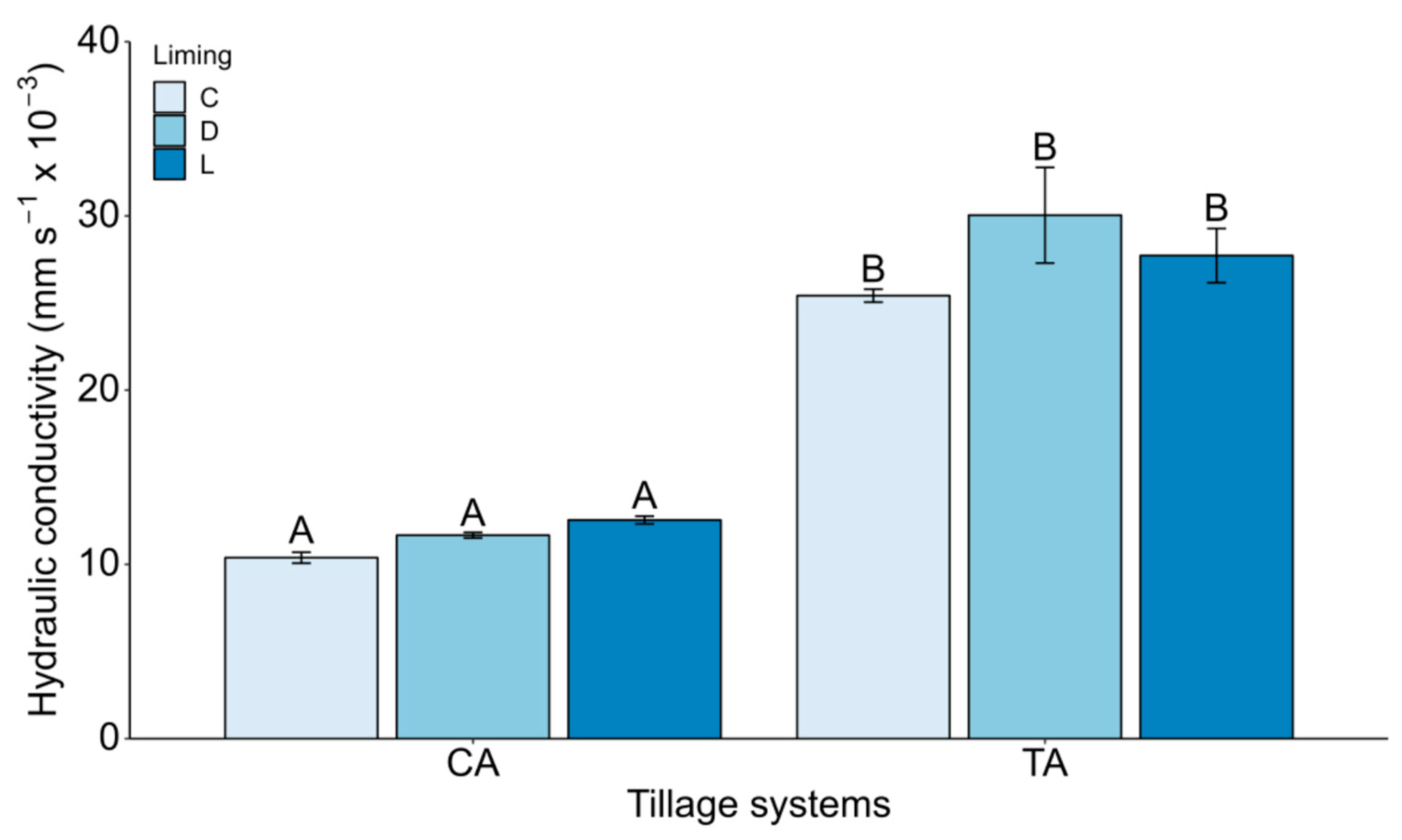
| Factors | K | Mg | Ca | Al | Ca/Mg | Mg/K | Ca/K | (Ca + Mg + K)/Al | pH |
|---|---|---|---|---|---|---|---|---|---|
| % | |||||||||
| Tillage systems (TS) | |||||||||
| CA | 2.58 ± 0.25 a | 7.29 ± 1.34 a | 60.95 ± 7.19 a | 29.18 ± 6.71 a | 12.60 ± 3.00 a | 2.97 ± 0.51 a | 29.76 ± 6.41 a | 20.55 ± 8.63 a | 5.51 ± 0.15 a |
| TA | 2.57 ± 0.03 a | 8.50 ± 1.72 a | 63.00 ± 6.68 a | 25.93 ± 6.13 a | 11.68 ± 2.67 a | 3.78 ± 0.75 a | 34.16 ± 7.74 a | 22.53 ± 8.79 a | 5.63 ± 0.15 a |
| Liming (Lg) | |||||||||
| C | 3.66 ± 0.20 a | 4.81 ± 0.27 b | 37.93 ± 1.26 c | 53.60 ± 1.55 a | 8.01 ± 0.42 b | 1.36 ± 0.10 c | 10.49 ± 0.39 c | 0.88 ± 0.05 b | 4.93 ± 0.05 b |
| L | 1.53 ± 0.12 c | 3.91 ± 0.30 b | 92.88 ± 0.32 a | 1.68 ± 0.13 c | 24.66 ± 1.73 a | 2.68 ± 0.28 b | 63.14 ± 4.54 a | 61.06 ± 4.81 a | 5.96 ± 0.10 a |
| D | 2.52 ± 0.12 b | 14.97 ± 0.65 a | 55.13 ± 0.50 b | 27.39 ± 0.96 b | 3.74 ± 0.14 c | 6.08 ± 0.49 a | 22.25 ± 1.10 b | 2.68 ± 0.14 b | 5.96 ± 0.10 a |
| TS×Lg | |||||||||
| CA×C | 3.44 ± 0.30 a | 4.72 ± 0.34 c | 35.82 ± 1.84 d | 56.03 ± 2.24 a | 7.68 ± 0.52 b | 1.43 ± 0.16 d | 10.58 ± 0.67 c | 0.8 ± 0.07 b | 4.88 ± 0.05 b |
| CA×L | 1.69 ± 0.21 c | 3.65 ± 0.33 c | 92.87 ± 0.42 a | 1.81 ± 0.25 e | 26.10 ± 2.32 a | 2.23 ± 0.10 d | 57.58 ± 6.61 a | 58.50 ± 9.94 a | 5.87 ± 0.03 a |
| CA×D | 2.60 ± 0.16 b | 13.52 ± 0.31 b | 54.18 ± 0.25 b | 29.71 ± 0.19 c | 4.03 ± 0.10 b | 5.25 ± 0.32 b | 21.13 ± 1.50 b | 2.35 ± 0.03 b | 5.88 ± 0.05 a |
| TA×C | 3.89 ± 0.24 a | 4.90 ± 0.47 c | 40.05 ± 1.03 c | 51.17 ± 1.48 b | 8.35 ± 0.68 b | 1.30 ± 0.12 d | 10.40 ± 0.49 c | 0.95 ± 0.06 b | 4.98 ± 0.09 b |
| TA×L | 1.38 ± 0.10 c | 4.18 ± 0.52 c | 92.89 ± 0.55 a | 1.55 ± 0.05 e | 23.23 ± 2.68 a | 3.13 ± 0.48 c | 68.70 ± 5.63 a | 63.63 ± 2.17 a | 6.03 ± 0.18 a |
| TA×D | 2.44 ± 0.19 b | 16.42 ± 0.69 a | 56.08 ± 0.71 b | 25.07 ± 0.84 d | 3.45 ± 0.17 b | 6.90 ± 0.75 a | 23.38 ± 1.60 b | 3.00 ± 0.14 b | 5.88 ± 0.03 a |
| Factors | Height (cm) | LAI | GF | DF | N | P | K | Ca | Mg |
|---|---|---|---|---|---|---|---|---|---|
| (t ha−1) | (g kg−1) | ||||||||
| Tillage system (TS) | |||||||||
| CA | 1.92 ± 0.04 b | 4.01 ± 0.19 a | 53.01 ± 1.50 b | 16.98 ± 0.41 b | 52.79 ± 1.14 a | 2.27 ± 0.07 b | 21.67 ± 0.67 a | 6.23 ± 0.28 b | 1.03 ± 0.03 b |
| TA | 1.95 ± 0.03 a | 4.08 ± 0.23 a | 59.46 ± 1.78 a | 17.66 ± 0.59 a | 50.18 ± 1.66 b | 2.18 ± 0.06 a | 21.31 ± 0.28 b | 8.03 ± 0.47 a | 1.52 ± 0.06 a |
| Liming (Lg) | |||||||||
| C | 1.92 ± 0.03 a | 3.58 ± 0.18 b | 55.45 ± 2.26 b | 16.81 ± 0.31 b | 49.01 ± 1.33 b | 1.99 ± 0.04 b | 22.18 ± 0.43 a | 6.19 ± 0.11 b | 1.19 ± 0.08 a |
| L | 1.91 ± 0.02 a | 4.72 ± 0.26 a | 60.30 ± 2.23 a | 18.72 ± 0.80 a | 56.24 ± 1.19 a | 2.11 ± 0.05 b | 19.89 ± 0.46 b | 8.13 ± 0.68 a | 1.35 ± 0.12 a |
| D | 1.98 ± 0.05 a | 3.85 ± 0.24 b | 52.95 ± 1.77 b | 16.41 ± 0.31 b | 49.21 ± 1.49 b | 2.43 ± 0.06 a | 22.40 ± 0.57 a | 7.08 ± 0.55 b | 1.29 ± 0.12 a |
| TS ×Lg | |||||||||
| CA×C | 1.91 ± 0.04 b | 3.42 ± 0.23 b | 51.15 ± 1.34 a | 16.48 ± 0.52 b | 49.93 ± 2.18 b | 2.00 ± 0.08 b | 22.48 ± 0.48 b | 6.18 ± 0.18 b | 1.00 ± 0.04 b |
| CA×L | 1.87 ± 0.03 b | 4.28 ± 0.29 b | 57.14 ± 2.87 a | 17.72 ± 1.02 b | 59.68 ± 2.26 a | 2.08 ± 0.08 b | 18.80 ± 0.25 c | 6.70 ± 0.79 b | 1.08 ± 0.05 b |
| CA×D | 1.98 ± 0.10 b | 4.34 ± 0.36 b | 50.75 ± 2.47 a | 16.36 ± 0.47 b | 53.53 ± 1.42 b | 2.43 ± 0.12 a | 23.73 ± 0.58 a | 5.80 ± 0.24 b | 1.03 ± 0.09 b |
| TA×C | 1.93 ± 0.05 a | 3.74 ± 0.28 b | 59.76 ± 3.10 a | 16.78 ± 0.44 b | 54.43 ± 2.78 b | 1.98 ± 0.05 b | 21.88 ± 0.76 b | 6.20 ± 0.16 b | 1.38 ± 0.08 a |
| TA×L | 1.94 ± 0.01 a | 5.16 ± 0.37 a | 63.47 ± 2.87 a | 19.72 ± 1.12 a | 58.40 ± 1.94 a | 2.15 ± 0.06 b | 20.98 ± 0.35 b | 9.55 ± 0.45 a | 1.63 ± 0.12 a |
| TA×D | 1.98 ± 0.05 a | 3.35 ± 0.19 b | 55.14 ± 2.29 a | 16.47 ± 0.49 b | 47.30 ± 2.28 b | 2.43 ± 0.08 a | 21.08 ± 0.15 b | 8.35 ± 0.51 a | 1.55 ± 0.10 a |
Disclaimer/Publisher’s Note: The statements, opinions and data contained in all publications are solely those of the individual author(s) and contributor(s) and not of MDPI and/or the editor(s). MDPI and/or the editor(s) disclaim responsibility for any injury to people or property resulting from any ideas, methods, instructions or products referred to in the content. |
© 2024 by the authors. Licensee MDPI, Basel, Switzerland. This article is an open access article distributed under the terms and conditions of the Creative Commons Attribution (CC BY) license (https://creativecommons.org/licenses/by/4.0/).
Share and Cite
Ocaña-Reyes, J.A.; Gutiérrez, M.; Paredes-Espinosa, R.; Riveros, C.A.; Cárdenas, G.P.; Bravo, N.; Quispe-Tomas, A.; Amaringo-Cordova, L.P.; Ocaña-Canales, J.C.; Zavala-Solórzano, J.W.; et al. Tillage Practices and Liming: Comparative Study of Soil Properties and Forage Corn Production. Agronomy 2024, 14, 558. https://doi.org/10.3390/agronomy14030558
Ocaña-Reyes JA, Gutiérrez M, Paredes-Espinosa R, Riveros CA, Cárdenas GP, Bravo N, Quispe-Tomas A, Amaringo-Cordova LP, Ocaña-Canales JC, Zavala-Solórzano JW, et al. Tillage Practices and Liming: Comparative Study of Soil Properties and Forage Corn Production. Agronomy. 2024; 14(3):558. https://doi.org/10.3390/agronomy14030558
Chicago/Turabian StyleOcaña-Reyes, Jimmy A., Marco Gutiérrez, Richard Paredes-Espinosa, Christian A. Riveros, Gloria P. Cárdenas, Nino Bravo, Astrid Quispe-Tomas, Luiz P. Amaringo-Cordova, Juan C. Ocaña-Canales, José W. Zavala-Solórzano, and et al. 2024. "Tillage Practices and Liming: Comparative Study of Soil Properties and Forage Corn Production" Agronomy 14, no. 3: 558. https://doi.org/10.3390/agronomy14030558
APA StyleOcaña-Reyes, J. A., Gutiérrez, M., Paredes-Espinosa, R., Riveros, C. A., Cárdenas, G. P., Bravo, N., Quispe-Tomas, A., Amaringo-Cordova, L. P., Ocaña-Canales, J. C., Zavala-Solórzano, J. W., Huamaní Yupanqui, H. A., Cruz, J., & Solórzano-Acosta, R. (2024). Tillage Practices and Liming: Comparative Study of Soil Properties and Forage Corn Production. Agronomy, 14(3), 558. https://doi.org/10.3390/agronomy14030558







